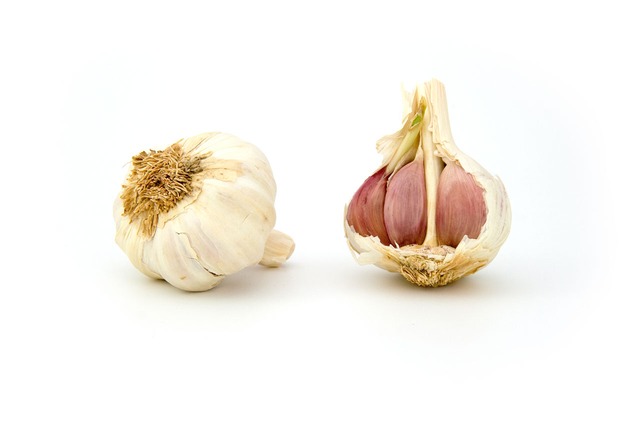Family: Liliaceae
Common names: Rashun (Bengali); Garlic (English).
Description:
Garlic is cultivated all over the country as a spice plant. It is a perennial herb with narrow, angular, long, fleshy and slightly grayish leaves, rounded flower heads and numerous small bulbs borne in a group and surrounded by a white papery sheath.

Parts used:
Fresh bulbs, garlic powder, and garlic oil.
Chemical constituents:
Chief chemical constituent of Garlic is an essential oil, which contains allyl propyl disulphide, diallyl disulphide, dimethyl disulphide and polysulphides. The sulphur compounds include allicin, alliin, cycloalliin, ajoene, allisatin I & II and sativins. It also contains anthocyanins, carbohydrates, proteins, amino acids, glycosides of kaempferol and quercebn, saponin-like substances, sterols (beta-sitosterol, cholesterol, and campesterol), vitamins and polysaccharides. Four steroidal saponins, protoisoeruboside, eruboside-B, isoeruboside-B, sativioside C, and two amino acids, adensine, and tryptophan, have been isolated from the fresh bulbs. Vitamins A, B, C and alpha-tocopherol (vitamin E) have also been isolated from garlic. Garlic also contains prostaglandins A2 and F1.
Therapeutic properties and Uses:
Garlic counters many infections, including those of the nose, throat, and chest. It reduces cholesterol, helps circulatory disorders, such as high blood pressure, and lowers blood sugar levels. Garlic also offers significant protection against heart disease and strokes and reduces levels of serum lipids and is an effective drug for a number of other diseases, which include fever rheumatism, diabetes, blood pressure, and intestinal diseases. It is used as a stimulant, carminative, anthelmintic, hypoglycaemic, diuretic, aphrodisiac, tonic, alterative, hypotensive, anti-inflammatory, anti-microbial, and blood cholesterol-reducing drug. Garlic is an antiseptic and expectorant, and is used in wounds, leprosy, coughs, piles, painful menstruation, abdominal pains, and earache. It is given in indigestion, gas formation, headache, asthma, and whooping cough. Its juice is regarded as a hair tonic. Garlic is used as a popular household remedy for a variety of common ailments in addition to its use as a common condiment in cooking.
Numerous studies in animals and humans have demonstrated antimicrobial, antiviral, anti-inflammatory, immune-enhancing, lipid-lowering and anticancer properties of Garlic. It has been successfully used in the treatment of a female candidiasis patient with severe infestation of pathogenic Candida lusitaniae. Aqueous extracts of Garlic and its constituent allicin have been found to have significant activity against a large number of pathogenic bacteria. It also produces inhibitory effects on Gram-positive germs of typhoid-paratyphoid-enteritis group. Allicin is a bactericide, fungicide, and germicide and possesses anti-tumour and hypoglycemic properties.
Preparation and Dosage:
Fresh bulbs, 4 gm daily dose, powdered dried bulbs in capsules or as tablets and essential oil of garlic are used.
